Comparative Analysis of Costing Methods: Management Accounting Report
VerifiedAdded on 2021/06/18
|11
|2461
|92
Report
AI Summary
This report provides an in-depth analysis of costing techniques used in management accounting, with a particular focus on the Australian business context. It begins by examining the principles of both traditional costing methods, specifically absorption costing, and activity-based costing (ABC). The report delves into the advantages and disadvantages of each approach, highlighting the strengths and weaknesses of absorption costing in terms of its simplicity and regulatory compliance versus the enhanced accuracy and detailed cost allocation offered by ABC. The literature review supports the shift towards ABC, emphasizing its relevance in today's complex business environments. The report concludes with a comparative analysis, offering recommendations on the optimal costing technique for businesses seeking to accurately measure and allocate costs, ultimately suggesting that ABC is the more effective and modern method. The report includes a detailed comparison of the two methods with their pros and cons, and it recommends ABC model of costing for better presentation of financial data.
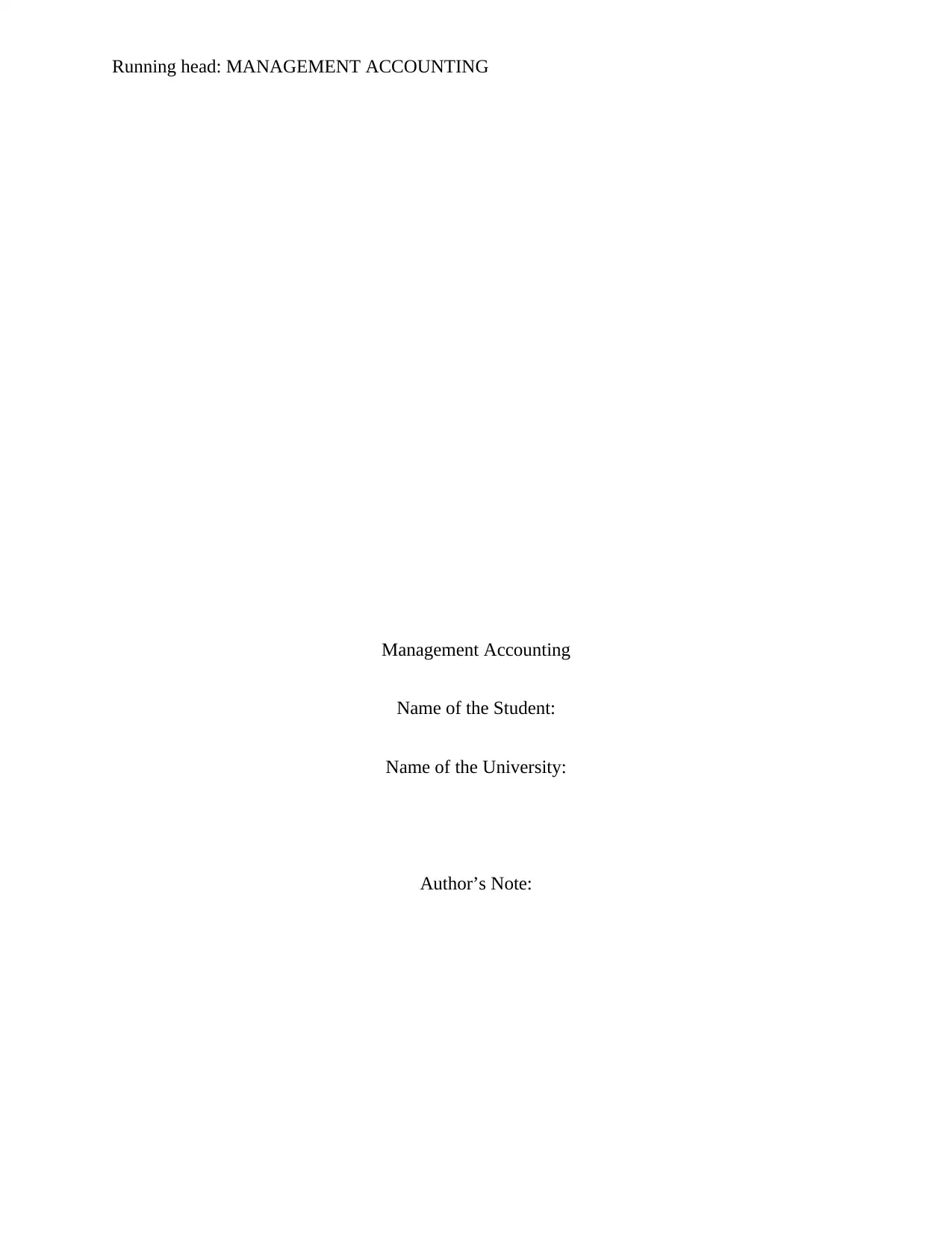
Running head: MANAGEMENT ACCOUNTING
Management Accounting
Name of the Student:
Name of the University:
Author’s Note:
Management Accounting
Name of the Student:
Name of the University:
Author’s Note:
Paraphrase This Document
Need a fresh take? Get an instant paraphrase of this document with our AI Paraphraser
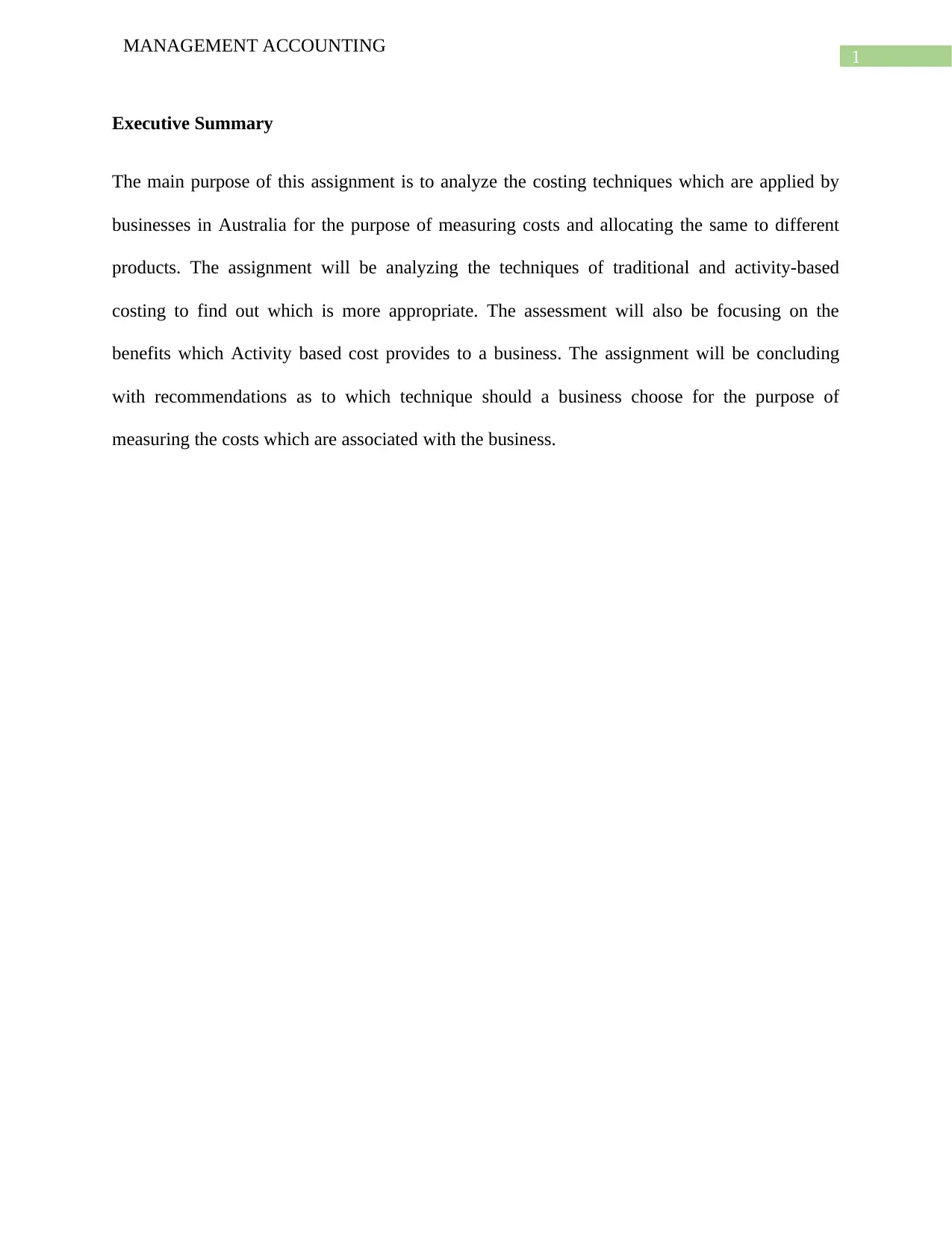
1
MANAGEMENT ACCOUNTING
Executive Summary
The main purpose of this assignment is to analyze the costing techniques which are applied by
businesses in Australia for the purpose of measuring costs and allocating the same to different
products. The assignment will be analyzing the techniques of traditional and activity-based
costing to find out which is more appropriate. The assessment will also be focusing on the
benefits which Activity based cost provides to a business. The assignment will be concluding
with recommendations as to which technique should a business choose for the purpose of
measuring the costs which are associated with the business.
MANAGEMENT ACCOUNTING
Executive Summary
The main purpose of this assignment is to analyze the costing techniques which are applied by
businesses in Australia for the purpose of measuring costs and allocating the same to different
products. The assignment will be analyzing the techniques of traditional and activity-based
costing to find out which is more appropriate. The assessment will also be focusing on the
benefits which Activity based cost provides to a business. The assignment will be concluding
with recommendations as to which technique should a business choose for the purpose of
measuring the costs which are associated with the business.
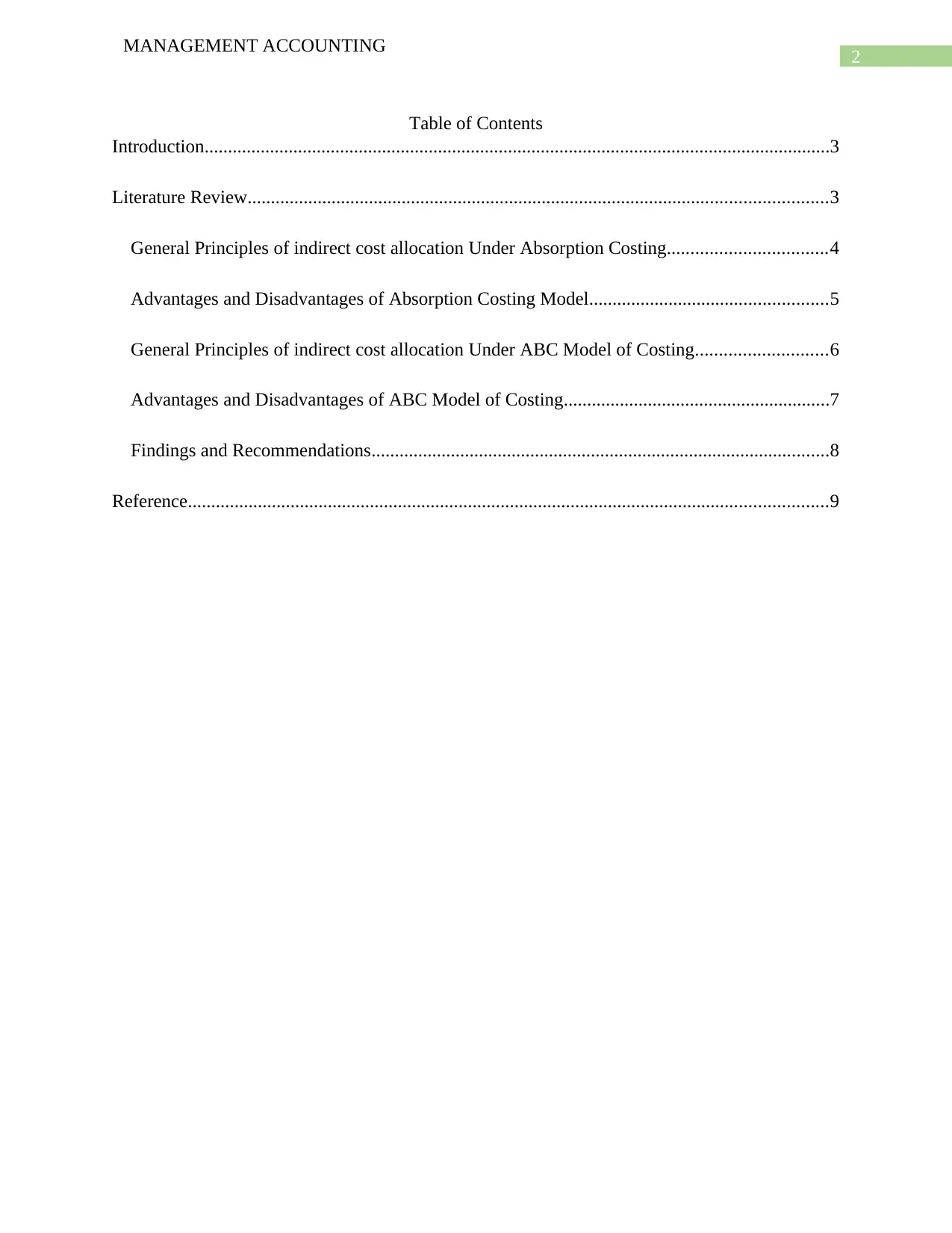
2
MANAGEMENT ACCOUNTING
Table of Contents
Introduction......................................................................................................................................3
Literature Review............................................................................................................................3
General Principles of indirect cost allocation Under Absorption Costing..................................4
Advantages and Disadvantages of Absorption Costing Model...................................................5
General Principles of indirect cost allocation Under ABC Model of Costing............................6
Advantages and Disadvantages of ABC Model of Costing.........................................................7
Findings and Recommendations..................................................................................................8
Reference.........................................................................................................................................9
MANAGEMENT ACCOUNTING
Table of Contents
Introduction......................................................................................................................................3
Literature Review............................................................................................................................3
General Principles of indirect cost allocation Under Absorption Costing..................................4
Advantages and Disadvantages of Absorption Costing Model...................................................5
General Principles of indirect cost allocation Under ABC Model of Costing............................6
Advantages and Disadvantages of ABC Model of Costing.........................................................7
Findings and Recommendations..................................................................................................8
Reference.........................................................................................................................................9
⊘ This is a preview!⊘
Do you want full access?
Subscribe today to unlock all pages.

Trusted by 1+ million students worldwide
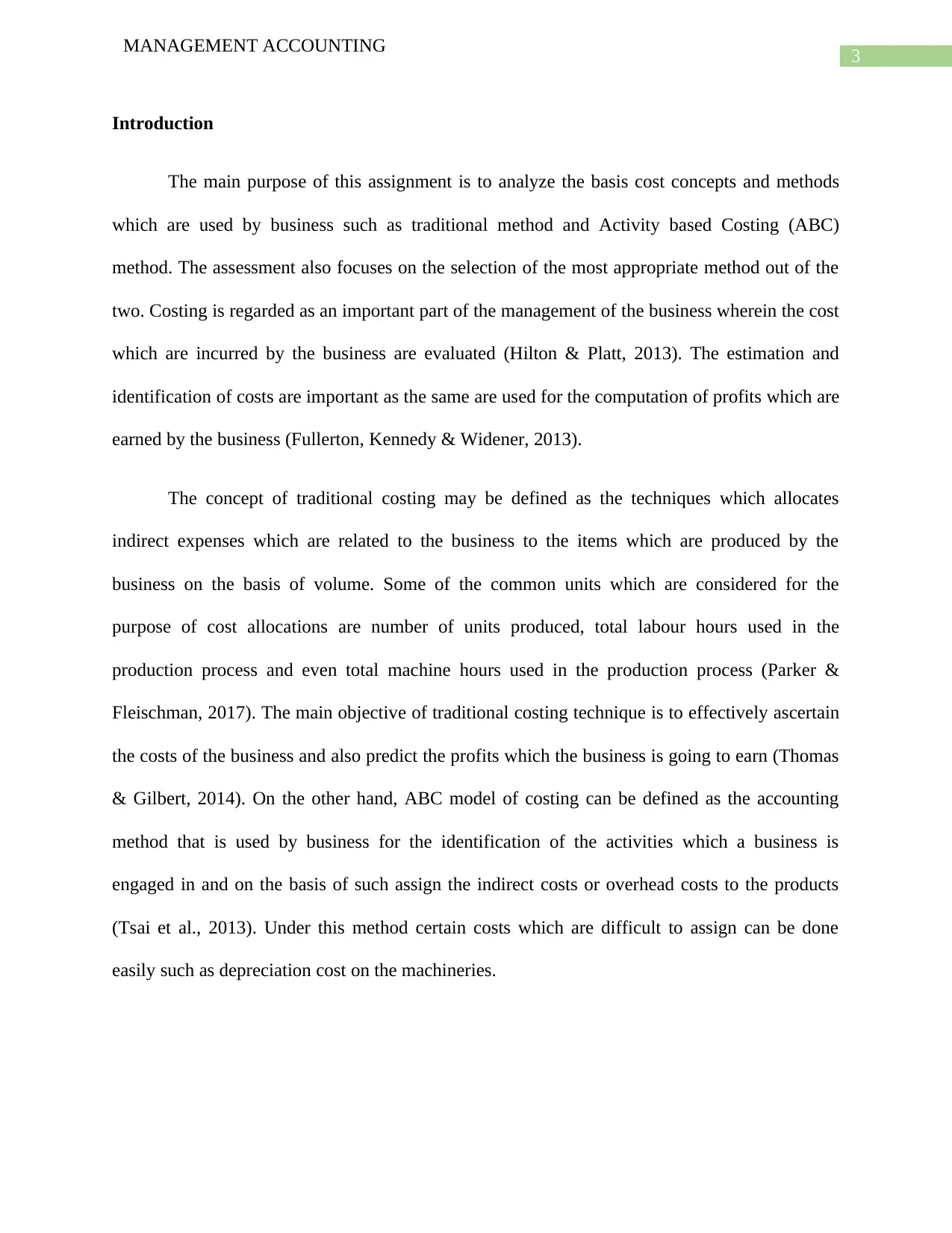
3
MANAGEMENT ACCOUNTING
Introduction
The main purpose of this assignment is to analyze the basis cost concepts and methods
which are used by business such as traditional method and Activity based Costing (ABC)
method. The assessment also focuses on the selection of the most appropriate method out of the
two. Costing is regarded as an important part of the management of the business wherein the cost
which are incurred by the business are evaluated (Hilton & Platt, 2013). The estimation and
identification of costs are important as the same are used for the computation of profits which are
earned by the business (Fullerton, Kennedy & Widener, 2013).
The concept of traditional costing may be defined as the techniques which allocates
indirect expenses which are related to the business to the items which are produced by the
business on the basis of volume. Some of the common units which are considered for the
purpose of cost allocations are number of units produced, total labour hours used in the
production process and even total machine hours used in the production process (Parker &
Fleischman, 2017). The main objective of traditional costing technique is to effectively ascertain
the costs of the business and also predict the profits which the business is going to earn (Thomas
& Gilbert, 2014). On the other hand, ABC model of costing can be defined as the accounting
method that is used by business for the identification of the activities which a business is
engaged in and on the basis of such assign the indirect costs or overhead costs to the products
(Tsai et al., 2013). Under this method certain costs which are difficult to assign can be done
easily such as depreciation cost on the machineries.
MANAGEMENT ACCOUNTING
Introduction
The main purpose of this assignment is to analyze the basis cost concepts and methods
which are used by business such as traditional method and Activity based Costing (ABC)
method. The assessment also focuses on the selection of the most appropriate method out of the
two. Costing is regarded as an important part of the management of the business wherein the cost
which are incurred by the business are evaluated (Hilton & Platt, 2013). The estimation and
identification of costs are important as the same are used for the computation of profits which are
earned by the business (Fullerton, Kennedy & Widener, 2013).
The concept of traditional costing may be defined as the techniques which allocates
indirect expenses which are related to the business to the items which are produced by the
business on the basis of volume. Some of the common units which are considered for the
purpose of cost allocations are number of units produced, total labour hours used in the
production process and even total machine hours used in the production process (Parker &
Fleischman, 2017). The main objective of traditional costing technique is to effectively ascertain
the costs of the business and also predict the profits which the business is going to earn (Thomas
& Gilbert, 2014). On the other hand, ABC model of costing can be defined as the accounting
method that is used by business for the identification of the activities which a business is
engaged in and on the basis of such assign the indirect costs or overhead costs to the products
(Tsai et al., 2013). Under this method certain costs which are difficult to assign can be done
easily such as depreciation cost on the machineries.
Paraphrase This Document
Need a fresh take? Get an instant paraphrase of this document with our AI Paraphraser
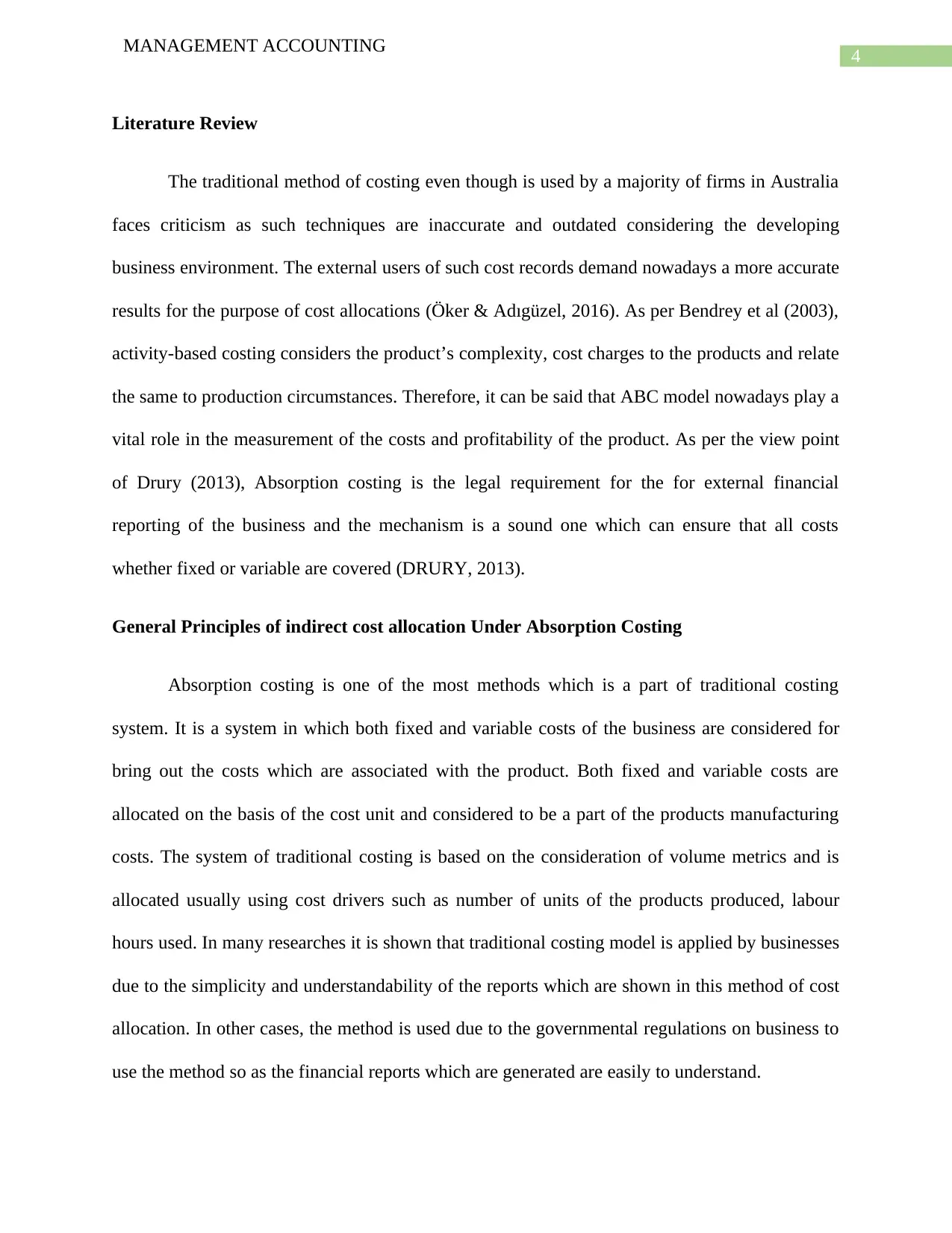
4
MANAGEMENT ACCOUNTING
Literature Review
The traditional method of costing even though is used by a majority of firms in Australia
faces criticism as such techniques are inaccurate and outdated considering the developing
business environment. The external users of such cost records demand nowadays a more accurate
results for the purpose of cost allocations (Öker & Adıgüzel, 2016). As per Bendrey et al (2003),
activity-based costing considers the product’s complexity, cost charges to the products and relate
the same to production circumstances. Therefore, it can be said that ABC model nowadays play a
vital role in the measurement of the costs and profitability of the product. As per the view point
of Drury (2013), Absorption costing is the legal requirement for the for external financial
reporting of the business and the mechanism is a sound one which can ensure that all costs
whether fixed or variable are covered (DRURY, 2013).
General Principles of indirect cost allocation Under Absorption Costing
Absorption costing is one of the most methods which is a part of traditional costing
system. It is a system in which both fixed and variable costs of the business are considered for
bring out the costs which are associated with the product. Both fixed and variable costs are
allocated on the basis of the cost unit and considered to be a part of the products manufacturing
costs. The system of traditional costing is based on the consideration of volume metrics and is
allocated usually using cost drivers such as number of units of the products produced, labour
hours used. In many researches it is shown that traditional costing model is applied by businesses
due to the simplicity and understandability of the reports which are shown in this method of cost
allocation. In other cases, the method is used due to the governmental regulations on business to
use the method so as the financial reports which are generated are easily to understand.
MANAGEMENT ACCOUNTING
Literature Review
The traditional method of costing even though is used by a majority of firms in Australia
faces criticism as such techniques are inaccurate and outdated considering the developing
business environment. The external users of such cost records demand nowadays a more accurate
results for the purpose of cost allocations (Öker & Adıgüzel, 2016). As per Bendrey et al (2003),
activity-based costing considers the product’s complexity, cost charges to the products and relate
the same to production circumstances. Therefore, it can be said that ABC model nowadays play a
vital role in the measurement of the costs and profitability of the product. As per the view point
of Drury (2013), Absorption costing is the legal requirement for the for external financial
reporting of the business and the mechanism is a sound one which can ensure that all costs
whether fixed or variable are covered (DRURY, 2013).
General Principles of indirect cost allocation Under Absorption Costing
Absorption costing is one of the most methods which is a part of traditional costing
system. It is a system in which both fixed and variable costs of the business are considered for
bring out the costs which are associated with the product. Both fixed and variable costs are
allocated on the basis of the cost unit and considered to be a part of the products manufacturing
costs. The system of traditional costing is based on the consideration of volume metrics and is
allocated usually using cost drivers such as number of units of the products produced, labour
hours used. In many researches it is shown that traditional costing model is applied by businesses
due to the simplicity and understandability of the reports which are shown in this method of cost
allocation. In other cases, the method is used due to the governmental regulations on business to
use the method so as the financial reports which are generated are easily to understand.
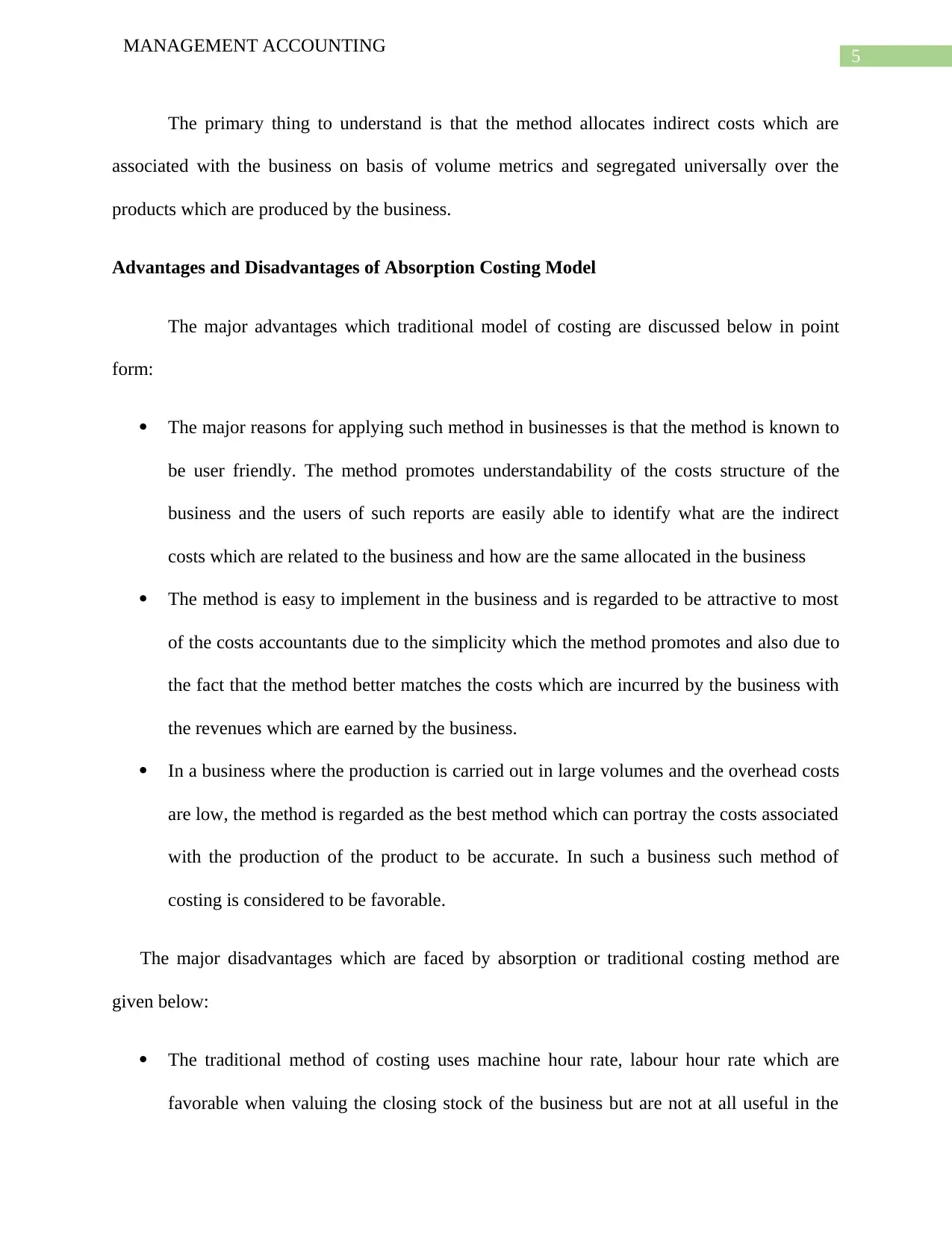
5
MANAGEMENT ACCOUNTING
The primary thing to understand is that the method allocates indirect costs which are
associated with the business on basis of volume metrics and segregated universally over the
products which are produced by the business.
Advantages and Disadvantages of Absorption Costing Model
The major advantages which traditional model of costing are discussed below in point
form:
The major reasons for applying such method in businesses is that the method is known to
be user friendly. The method promotes understandability of the costs structure of the
business and the users of such reports are easily able to identify what are the indirect
costs which are related to the business and how are the same allocated in the business
The method is easy to implement in the business and is regarded to be attractive to most
of the costs accountants due to the simplicity which the method promotes and also due to
the fact that the method better matches the costs which are incurred by the business with
the revenues which are earned by the business.
In a business where the production is carried out in large volumes and the overhead costs
are low, the method is regarded as the best method which can portray the costs associated
with the production of the product to be accurate. In such a business such method of
costing is considered to be favorable.
The major disadvantages which are faced by absorption or traditional costing method are
given below:
The traditional method of costing uses machine hour rate, labour hour rate which are
favorable when valuing the closing stock of the business but are not at all useful in the
MANAGEMENT ACCOUNTING
The primary thing to understand is that the method allocates indirect costs which are
associated with the business on basis of volume metrics and segregated universally over the
products which are produced by the business.
Advantages and Disadvantages of Absorption Costing Model
The major advantages which traditional model of costing are discussed below in point
form:
The major reasons for applying such method in businesses is that the method is known to
be user friendly. The method promotes understandability of the costs structure of the
business and the users of such reports are easily able to identify what are the indirect
costs which are related to the business and how are the same allocated in the business
The method is easy to implement in the business and is regarded to be attractive to most
of the costs accountants due to the simplicity which the method promotes and also due to
the fact that the method better matches the costs which are incurred by the business with
the revenues which are earned by the business.
In a business where the production is carried out in large volumes and the overhead costs
are low, the method is regarded as the best method which can portray the costs associated
with the production of the product to be accurate. In such a business such method of
costing is considered to be favorable.
The major disadvantages which are faced by absorption or traditional costing method are
given below:
The traditional method of costing uses machine hour rate, labour hour rate which are
favorable when valuing the closing stock of the business but are not at all useful in the
⊘ This is a preview!⊘
Do you want full access?
Subscribe today to unlock all pages.

Trusted by 1+ million students worldwide
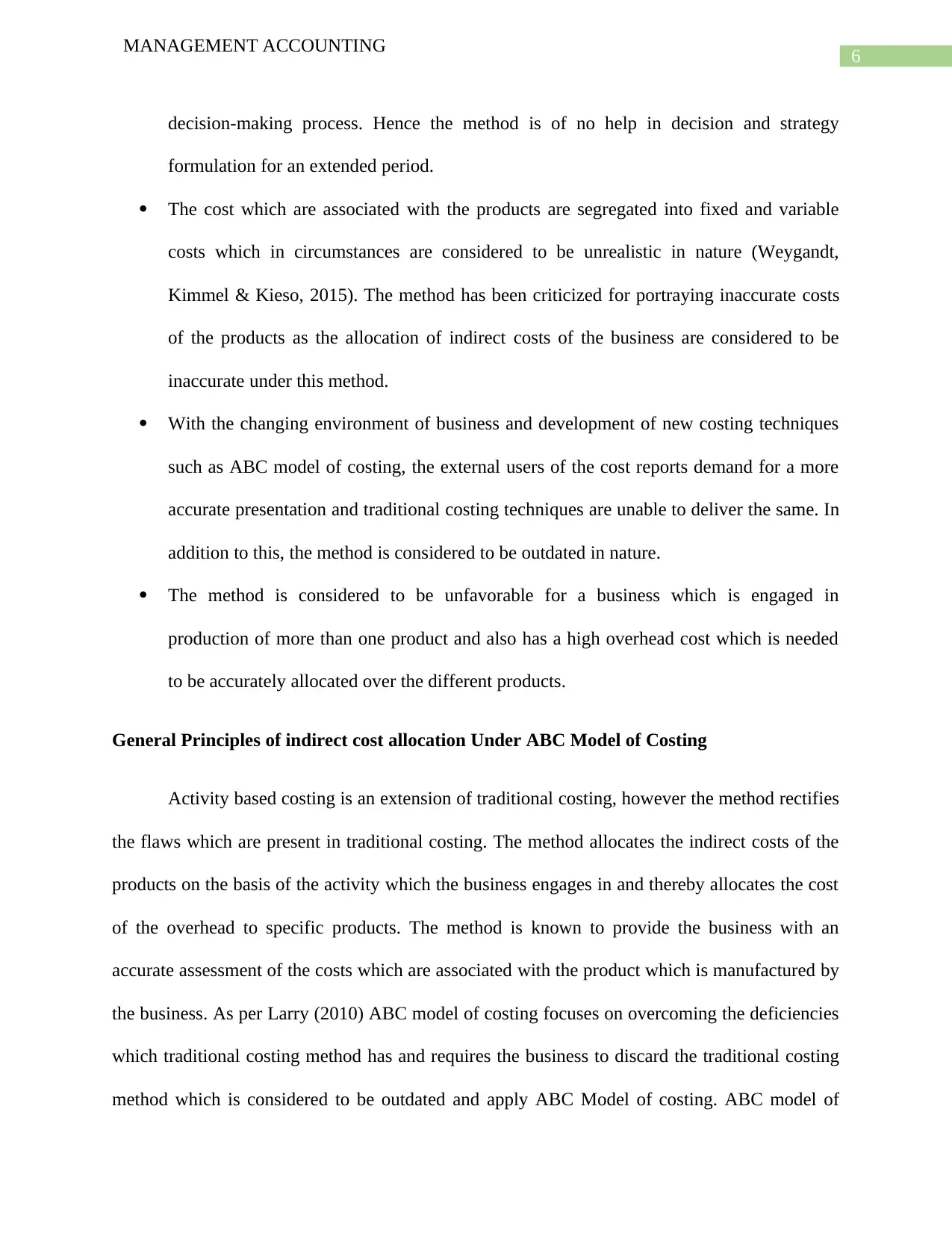
6
MANAGEMENT ACCOUNTING
decision-making process. Hence the method is of no help in decision and strategy
formulation for an extended period.
The cost which are associated with the products are segregated into fixed and variable
costs which in circumstances are considered to be unrealistic in nature (Weygandt,
Kimmel & Kieso, 2015). The method has been criticized for portraying inaccurate costs
of the products as the allocation of indirect costs of the business are considered to be
inaccurate under this method.
With the changing environment of business and development of new costing techniques
such as ABC model of costing, the external users of the cost reports demand for a more
accurate presentation and traditional costing techniques are unable to deliver the same. In
addition to this, the method is considered to be outdated in nature.
The method is considered to be unfavorable for a business which is engaged in
production of more than one product and also has a high overhead cost which is needed
to be accurately allocated over the different products.
General Principles of indirect cost allocation Under ABC Model of Costing
Activity based costing is an extension of traditional costing, however the method rectifies
the flaws which are present in traditional costing. The method allocates the indirect costs of the
products on the basis of the activity which the business engages in and thereby allocates the cost
of the overhead to specific products. The method is known to provide the business with an
accurate assessment of the costs which are associated with the product which is manufactured by
the business. As per Larry (2010) ABC model of costing focuses on overcoming the deficiencies
which traditional costing method has and requires the business to discard the traditional costing
method which is considered to be outdated and apply ABC Model of costing. ABC model of
MANAGEMENT ACCOUNTING
decision-making process. Hence the method is of no help in decision and strategy
formulation for an extended period.
The cost which are associated with the products are segregated into fixed and variable
costs which in circumstances are considered to be unrealistic in nature (Weygandt,
Kimmel & Kieso, 2015). The method has been criticized for portraying inaccurate costs
of the products as the allocation of indirect costs of the business are considered to be
inaccurate under this method.
With the changing environment of business and development of new costing techniques
such as ABC model of costing, the external users of the cost reports demand for a more
accurate presentation and traditional costing techniques are unable to deliver the same. In
addition to this, the method is considered to be outdated in nature.
The method is considered to be unfavorable for a business which is engaged in
production of more than one product and also has a high overhead cost which is needed
to be accurately allocated over the different products.
General Principles of indirect cost allocation Under ABC Model of Costing
Activity based costing is an extension of traditional costing, however the method rectifies
the flaws which are present in traditional costing. The method allocates the indirect costs of the
products on the basis of the activity which the business engages in and thereby allocates the cost
of the overhead to specific products. The method is known to provide the business with an
accurate assessment of the costs which are associated with the product which is manufactured by
the business. As per Larry (2010) ABC model of costing focuses on overcoming the deficiencies
which traditional costing method has and requires the business to discard the traditional costing
method which is considered to be outdated and apply ABC Model of costing. ABC model of
Paraphrase This Document
Need a fresh take? Get an instant paraphrase of this document with our AI Paraphraser
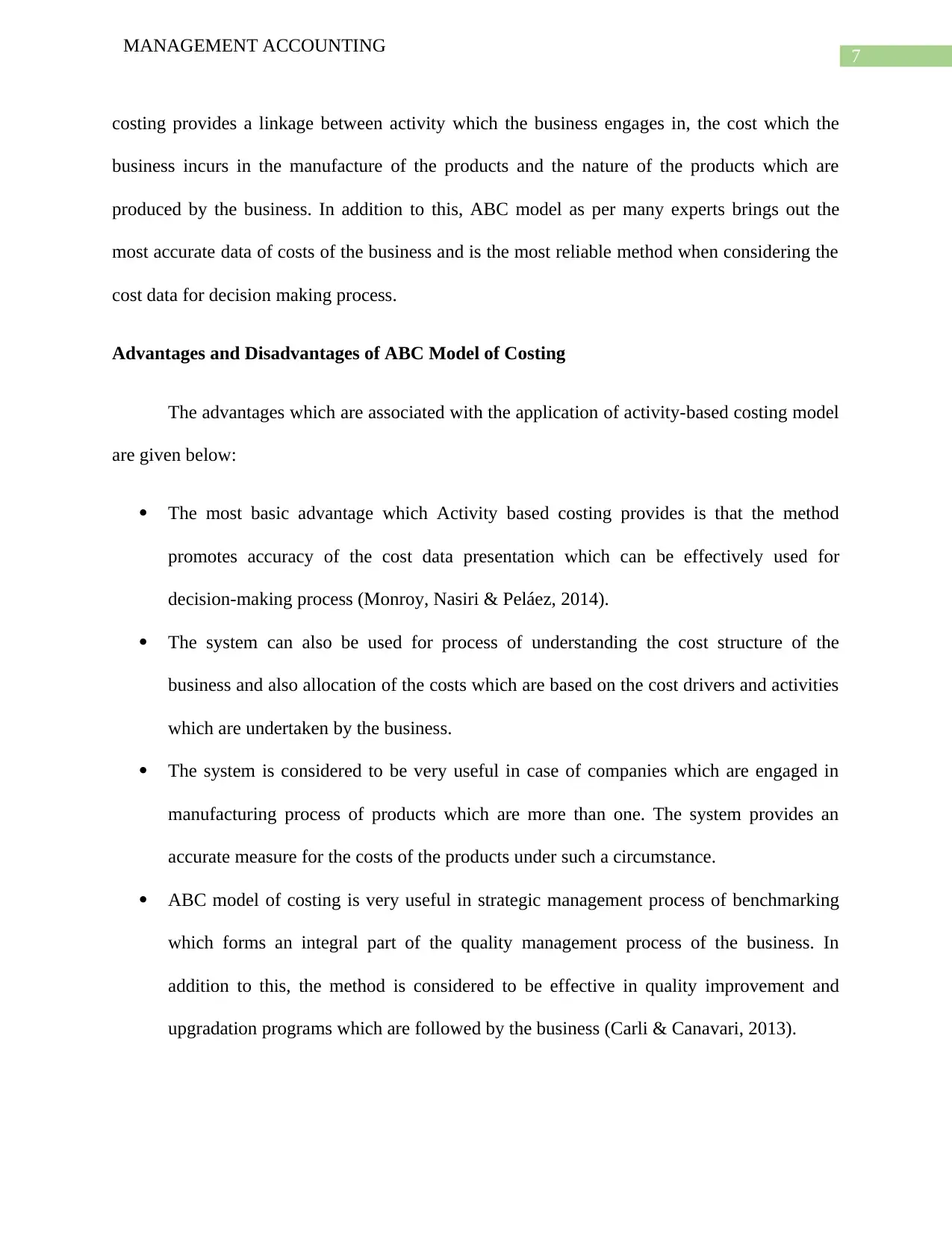
7
MANAGEMENT ACCOUNTING
costing provides a linkage between activity which the business engages in, the cost which the
business incurs in the manufacture of the products and the nature of the products which are
produced by the business. In addition to this, ABC model as per many experts brings out the
most accurate data of costs of the business and is the most reliable method when considering the
cost data for decision making process.
Advantages and Disadvantages of ABC Model of Costing
The advantages which are associated with the application of activity-based costing model
are given below:
The most basic advantage which Activity based costing provides is that the method
promotes accuracy of the cost data presentation which can be effectively used for
decision-making process (Monroy, Nasiri & Peláez, 2014).
The system can also be used for process of understanding the cost structure of the
business and also allocation of the costs which are based on the cost drivers and activities
which are undertaken by the business.
The system is considered to be very useful in case of companies which are engaged in
manufacturing process of products which are more than one. The system provides an
accurate measure for the costs of the products under such a circumstance.
ABC model of costing is very useful in strategic management process of benchmarking
which forms an integral part of the quality management process of the business. In
addition to this, the method is considered to be effective in quality improvement and
upgradation programs which are followed by the business (Carli & Canavari, 2013).
MANAGEMENT ACCOUNTING
costing provides a linkage between activity which the business engages in, the cost which the
business incurs in the manufacture of the products and the nature of the products which are
produced by the business. In addition to this, ABC model as per many experts brings out the
most accurate data of costs of the business and is the most reliable method when considering the
cost data for decision making process.
Advantages and Disadvantages of ABC Model of Costing
The advantages which are associated with the application of activity-based costing model
are given below:
The most basic advantage which Activity based costing provides is that the method
promotes accuracy of the cost data presentation which can be effectively used for
decision-making process (Monroy, Nasiri & Peláez, 2014).
The system can also be used for process of understanding the cost structure of the
business and also allocation of the costs which are based on the cost drivers and activities
which are undertaken by the business.
The system is considered to be very useful in case of companies which are engaged in
manufacturing process of products which are more than one. The system provides an
accurate measure for the costs of the products under such a circumstance.
ABC model of costing is very useful in strategic management process of benchmarking
which forms an integral part of the quality management process of the business. In
addition to this, the method is considered to be effective in quality improvement and
upgradation programs which are followed by the business (Carli & Canavari, 2013).
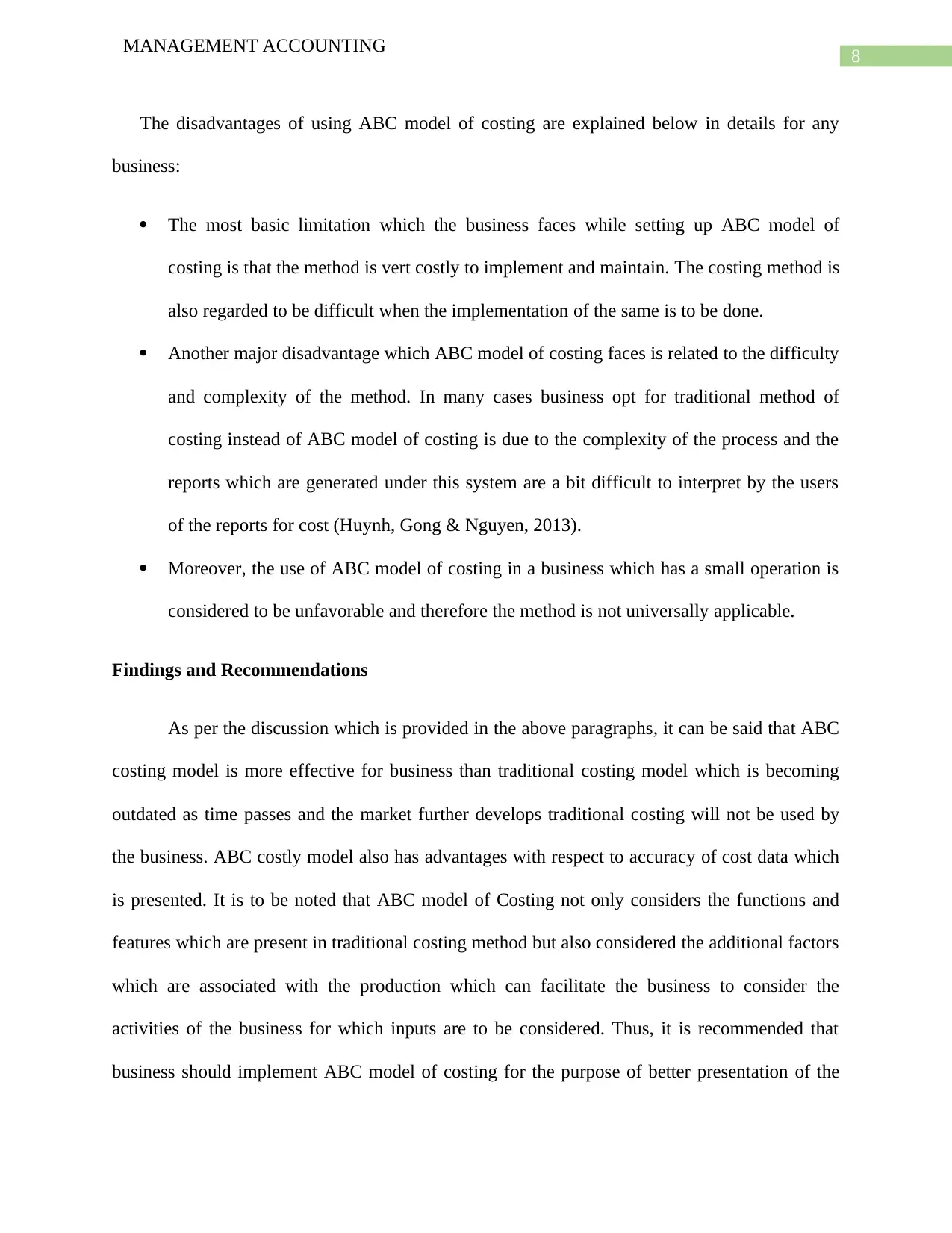
8
MANAGEMENT ACCOUNTING
The disadvantages of using ABC model of costing are explained below in details for any
business:
The most basic limitation which the business faces while setting up ABC model of
costing is that the method is vert costly to implement and maintain. The costing method is
also regarded to be difficult when the implementation of the same is to be done.
Another major disadvantage which ABC model of costing faces is related to the difficulty
and complexity of the method. In many cases business opt for traditional method of
costing instead of ABC model of costing is due to the complexity of the process and the
reports which are generated under this system are a bit difficult to interpret by the users
of the reports for cost (Huynh, Gong & Nguyen, 2013).
Moreover, the use of ABC model of costing in a business which has a small operation is
considered to be unfavorable and therefore the method is not universally applicable.
Findings and Recommendations
As per the discussion which is provided in the above paragraphs, it can be said that ABC
costing model is more effective for business than traditional costing model which is becoming
outdated as time passes and the market further develops traditional costing will not be used by
the business. ABC costly model also has advantages with respect to accuracy of cost data which
is presented. It is to be noted that ABC model of Costing not only considers the functions and
features which are present in traditional costing method but also considered the additional factors
which are associated with the production which can facilitate the business to consider the
activities of the business for which inputs are to be considered. Thus, it is recommended that
business should implement ABC model of costing for the purpose of better presentation of the
MANAGEMENT ACCOUNTING
The disadvantages of using ABC model of costing are explained below in details for any
business:
The most basic limitation which the business faces while setting up ABC model of
costing is that the method is vert costly to implement and maintain. The costing method is
also regarded to be difficult when the implementation of the same is to be done.
Another major disadvantage which ABC model of costing faces is related to the difficulty
and complexity of the method. In many cases business opt for traditional method of
costing instead of ABC model of costing is due to the complexity of the process and the
reports which are generated under this system are a bit difficult to interpret by the users
of the reports for cost (Huynh, Gong & Nguyen, 2013).
Moreover, the use of ABC model of costing in a business which has a small operation is
considered to be unfavorable and therefore the method is not universally applicable.
Findings and Recommendations
As per the discussion which is provided in the above paragraphs, it can be said that ABC
costing model is more effective for business than traditional costing model which is becoming
outdated as time passes and the market further develops traditional costing will not be used by
the business. ABC costly model also has advantages with respect to accuracy of cost data which
is presented. It is to be noted that ABC model of Costing not only considers the functions and
features which are present in traditional costing method but also considered the additional factors
which are associated with the production which can facilitate the business to consider the
activities of the business for which inputs are to be considered. Thus, it is recommended that
business should implement ABC model of costing for the purpose of better presentation of the
⊘ This is a preview!⊘
Do you want full access?
Subscribe today to unlock all pages.

Trusted by 1+ million students worldwide
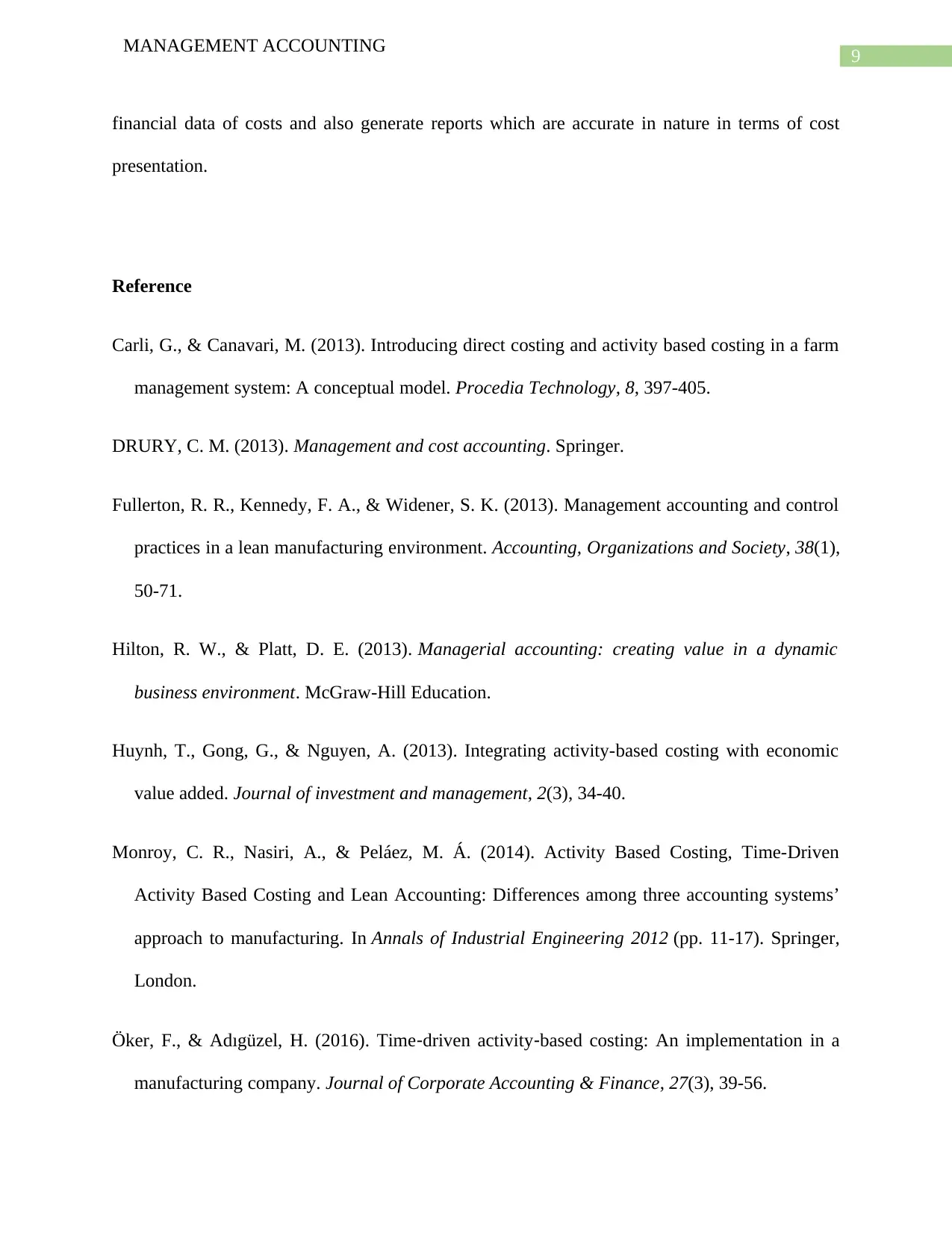
9
MANAGEMENT ACCOUNTING
financial data of costs and also generate reports which are accurate in nature in terms of cost
presentation.
Reference
Carli, G., & Canavari, M. (2013). Introducing direct costing and activity based costing in a farm
management system: A conceptual model. Procedia Technology, 8, 397-405.
DRURY, C. M. (2013). Management and cost accounting. Springer.
Fullerton, R. R., Kennedy, F. A., & Widener, S. K. (2013). Management accounting and control
practices in a lean manufacturing environment. Accounting, Organizations and Society, 38(1),
50-71.
Hilton, R. W., & Platt, D. E. (2013). Managerial accounting: creating value in a dynamic
business environment. McGraw-Hill Education.
Huynh, T., Gong, G., & Nguyen, A. (2013). Integrating activity-based costing with economic
value added. Journal of investment and management, 2(3), 34-40.
Monroy, C. R., Nasiri, A., & Peláez, M. Á. (2014). Activity Based Costing, Time-Driven
Activity Based Costing and Lean Accounting: Differences among three accounting systems’
approach to manufacturing. In Annals of Industrial Engineering 2012 (pp. 11-17). Springer,
London.
Öker, F., & Adıgüzel, H. (2016). Time‐driven activity‐based costing: An implementation in a
manufacturing company. Journal of Corporate Accounting & Finance, 27(3), 39-56.
MANAGEMENT ACCOUNTING
financial data of costs and also generate reports which are accurate in nature in terms of cost
presentation.
Reference
Carli, G., & Canavari, M. (2013). Introducing direct costing and activity based costing in a farm
management system: A conceptual model. Procedia Technology, 8, 397-405.
DRURY, C. M. (2013). Management and cost accounting. Springer.
Fullerton, R. R., Kennedy, F. A., & Widener, S. K. (2013). Management accounting and control
practices in a lean manufacturing environment. Accounting, Organizations and Society, 38(1),
50-71.
Hilton, R. W., & Platt, D. E. (2013). Managerial accounting: creating value in a dynamic
business environment. McGraw-Hill Education.
Huynh, T., Gong, G., & Nguyen, A. (2013). Integrating activity-based costing with economic
value added. Journal of investment and management, 2(3), 34-40.
Monroy, C. R., Nasiri, A., & Peláez, M. Á. (2014). Activity Based Costing, Time-Driven
Activity Based Costing and Lean Accounting: Differences among three accounting systems’
approach to manufacturing. In Annals of Industrial Engineering 2012 (pp. 11-17). Springer,
London.
Öker, F., & Adıgüzel, H. (2016). Time‐driven activity‐based costing: An implementation in a
manufacturing company. Journal of Corporate Accounting & Finance, 27(3), 39-56.
Paraphrase This Document
Need a fresh take? Get an instant paraphrase of this document with our AI Paraphraser
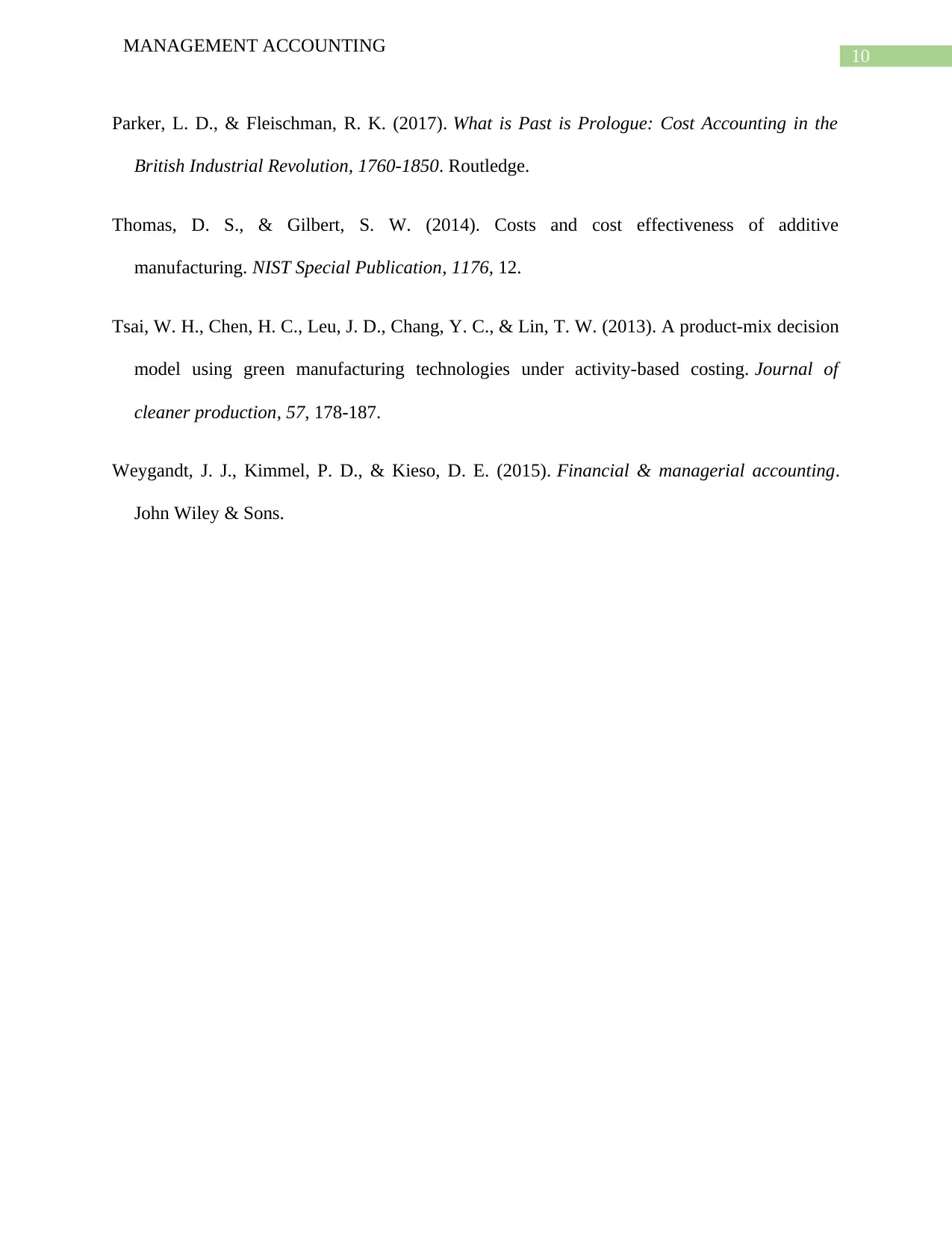
10
MANAGEMENT ACCOUNTING
Parker, L. D., & Fleischman, R. K. (2017). What is Past is Prologue: Cost Accounting in the
British Industrial Revolution, 1760-1850. Routledge.
Thomas, D. S., & Gilbert, S. W. (2014). Costs and cost effectiveness of additive
manufacturing. NIST Special Publication, 1176, 12.
Tsai, W. H., Chen, H. C., Leu, J. D., Chang, Y. C., & Lin, T. W. (2013). A product-mix decision
model using green manufacturing technologies under activity-based costing. Journal of
cleaner production, 57, 178-187.
Weygandt, J. J., Kimmel, P. D., & Kieso, D. E. (2015). Financial & managerial accounting.
John Wiley & Sons.
MANAGEMENT ACCOUNTING
Parker, L. D., & Fleischman, R. K. (2017). What is Past is Prologue: Cost Accounting in the
British Industrial Revolution, 1760-1850. Routledge.
Thomas, D. S., & Gilbert, S. W. (2014). Costs and cost effectiveness of additive
manufacturing. NIST Special Publication, 1176, 12.
Tsai, W. H., Chen, H. C., Leu, J. D., Chang, Y. C., & Lin, T. W. (2013). A product-mix decision
model using green manufacturing technologies under activity-based costing. Journal of
cleaner production, 57, 178-187.
Weygandt, J. J., Kimmel, P. D., & Kieso, D. E. (2015). Financial & managerial accounting.
John Wiley & Sons.
1 out of 11
Related Documents
Your All-in-One AI-Powered Toolkit for Academic Success.
+13062052269
info@desklib.com
Available 24*7 on WhatsApp / Email
![[object Object]](/_next/static/media/star-bottom.7253800d.svg)
Unlock your academic potential
Copyright © 2020–2025 A2Z Services. All Rights Reserved. Developed and managed by ZUCOL.




